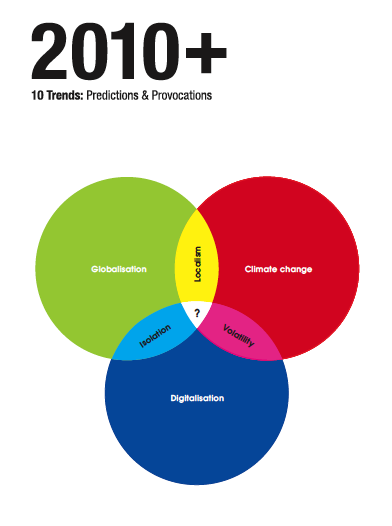
This is interesting. The average Twitter user has 27 followers. 80% of Twitter users have tweeted less than 10 times Only 17% of Twitter users are active These figures are from RJ Metrics (i.e. not Twitter) who looked at 2 million tweets from 50,000 users. Hence they should be taken with a large pinch of salt. Nevertheless things aren’t looking good.
Monthly Archives: February 2010
Unconscious thinking
If you have a problem to solve you should think about it right? Not necessarily.The conscious human mind has a very limited processing capacity. The traditional solution to this problem is to limit incoming information to only the most relevant data. It is also conventional wisdom that the longer you think about something the better your response. However, a recent experiment found quite the opposite. The more that people thought about something the more inclined they were to assemble irrelevant information and the less accurate their predictions became as a result. The implication is obviously that we should think about things less, either meaning that we should rely more on instant feelings and intuition or else defer to our unconscious mind. In other words sleep on it.
The power of intuition is of course nothing new. The question here though is whether extensive unconscious thought can make our intuition more reliable. It’s still early days (and nights) but the initial research seems to be saying yes. So what’s the takeaway here? Simply that we should use our conscious mind to collect data but then not think about it. We should allow our unconscious mind to digest the information and then follow our gut feeling.
Junk DNA?
A few years ago I wrote this in my book, Future Files:
“If you are charged with a criminal offence in the UK, a sample of your DNA is taken and added to a national DNA database where it stays indefinitely — even if you are subsequently acquitted. So far the UK database contains the profiles of 3,130,429 people, which is 5.23% of the entire UK population. In contrast the US DNA database contains just 0.99% of the US population, while most other national databases in the world contain the names of fewer than 100,000 people.
In theory this DNA fingerprinting is a very good idea, not least because the technology allows the police to create a DNA fingerprint using just a single human cell (taken from a print on a broken window for example). In the future police officers will carry handheld devices that can instantly upload these samples and test them against the database. These samples will then be used to create 3D photo fits of suspects, giving police officers accurate information on likely height, skin colour, hair colour and even personality type. Privacy campaigners are obviously concerned about this but the database and associated technology will be so useful that I’d expect the database to be enlarged as part of a national biometric identity card scheme.
Eventually until every single person in the country will therefore be listed “for their own security”, at which point adding some kind of GPS or other location tagging component would seem an entirely logical idea. The problem, of course, with this is that once a government starts to view all its citizens’ as potential suspects there will be subtle changes to how everything from policing to law making operates.”
Why am I telling you this? Because there’s a good article in this month’s issue of Washington Monthly. I quote:
“Is DNA evidence, a forensic tool known for exonerating the innocent, being used to put them behind bars? That’s what lawyer and journalist Michael Bobelian argues DNA has a reputation for being virtually foolproof. And, indeed, when fresh DNA evidence is used to confirm guilt of suspects who have been identified though eyewitness testimony or other means, as was traditionally the case, the chances of hitting on the wrong person can be as remote as one in many trillions. But increasingly law enforcement agencies are employing DNA in a new way: to find suspects in cases where the trail has gone cold. In these instances, the chances of accidentally fingering an innocent person can be as high as one in three–a staggering fact that juries weighing such cases are almost never told. ”
Link to full story in comments….
Coming Soon

I wrote most of this back in December and blogged about it extensively in early January. However, I’ve finally got around to putting it together nicely as a proper report (been a bit busy with the new book!). Free downloadable pdf coming soon…
Quote of the Week
“Nirvana is the absence of experience” – Jill Bolte Taylor, My Stroke of Insight: A Brain Scientist’s Personal Journey.
Boring is the new exciting
Takeaway from lunch with my mate Steve who works in funds management. According to Steve greed and stupidity are back. “So what’s changed?” I said. “Trust has evaporated” said Steve. Consequences? Possibly that the demand for simplicity with increase, as will the desire for authenticity and transparency.
BTW, I know that this post totally contradicts my last post, which was about sound bites, but get over it.
Gimme the facts – fast

Are you finding that you no longer have the time to read The Week (the weekly compendium of all the good bits from the world’s best newspapers)? If so I have just the thing for you. Go to Apple’s iTunes store and download something from the iMinds series – instant knowledge in just 9 minutes.
Yes, that’s right, learn about Astronomy, Confucius, the Magna Carta, Apartheid, the US Civil War, International Criminal Tribunals, Behavioral Economics or…wait for it…. Evolution in just 9 minutes! Mind you there is one slight problem. These miniature audio books don’t seem to tell you who is speaking and do not appear to give any sources for the material either.
BTW, I see there is even an iMinds on Gandi. You know, that Indian bloke wot said “There is more to life than increasing its speed.”
In Cyberspace Everyone Can Hear You Scream
Do you use Gmail, Google’s webmail service? If so you might have been rather upset a few weeks ago when something showed up in your inbox. Some people apparently got an invitation to try something called Buzz. Sounds innocent enough but if you clicked on it you were told that you were “following” a number of people and that a number of people were “following” you. Spam? No. Just another service from Google, albeit one you probably didn’t ask for.
How does it work? Simple. Google has gone through your email inbox and decided that some of those with whom you correspond are followees. Only problem is they didn’t actually ask you whether you wanted them to do this.
A few years ago you would have been at least asked whether you wanted your privacy invaded. Nowadays people just assume you won’t mind. This might seem like a storm in a teacup but think about it. Anyone that you are deemed to be “following” is now publicly available on your Google profile to anyone who takes a look. You can (eventually) remove this feature but why should you if you didn’t ask for it in the first place? In Cyberspace everyone can hear you screeeeeeam!
Technology Adoption
Nice quote just in from Matt Doyle…
“The writer Douglas Adams observed how technology that
existed when we were born seems normal, anything that is developed
before we turn 35 is exciting, and whatever comes after that is
treated with suspicion.”
Ref: Slate (see comments)
The Future (and History) of the Office
Where did offices come from? Perhaps if we understand the history of the office we will be in a better position to speculate about its future and debate how to adapt the modern office to modern needs.
It is generally accepted that the communal office was invented around 1900. Before this, people tended to work outdoors or at home. This included doctors and accountants who worked from rooms at home and shopkeepers who lived above their shop. Customers were local and companies, where they existed at all, were small.
So what gave rise to the rapid growth of office building? The main reason was the development of the factory. Mass production is not a new idea, going back to China and Greece thousands of years ago, but it is generally acknowledged that the factory production system as we know it today came into being around 1790 when Eli Whitney created mass-production techniques to satisfy the musket (i.e. rifle) needs of the US government. Henry Ford usually gets the credit for developing factory production after this although individuals such as Marc Isambard Brunel, Henry Maudslay, Samuel Colt and Elisha King Root made vital contributions. Regardless of who started things it was WW1 and WW2, when governments needed large quantities of armaments, that factory owners realised that they needed somewhere to house the growing number of clerical and administrative workers. Bingo, work as we know it today was born.
Another reason for the creation of the office was the invention of the typewriter. Before 1868 typewriters did not exist and so there was obviously no need to build rooms to house typists. Even after 1874 when Remington (the gun company) perfected the manual typewriter, demand for office assistants or typists was small. Later in 1920 when Olivetti invented the electric typewriter demand was still relatively modest. There was simply nothing much to type back then. This all changed in the 1950s when consumerism, global markets and information processing power really took off but it is worth remembering that the communal office is a very recent invention and therefore we should not be afraid to turn it upside down and re-invent it if necessary.
In the early years, discipline and control were everything and formal organisational hierarchies were translated into large rooms full of identical desks, watched over by a large clock and someone in charge. But things have now changed and I believe that it is time to re-think how employees interact with each other in physical and virtual spaces and also time to reflect on how environments (and the tools found in these environments) can be used to improve the quality of thinking.
